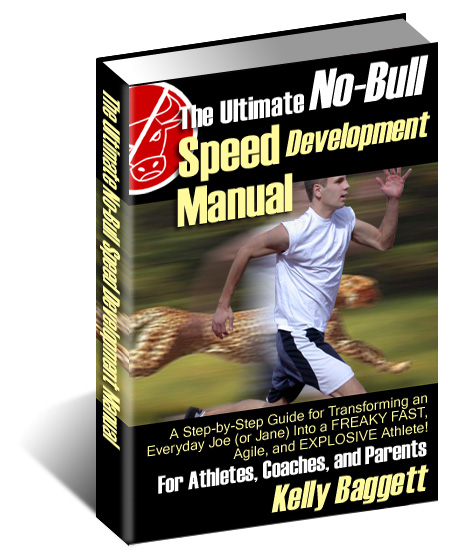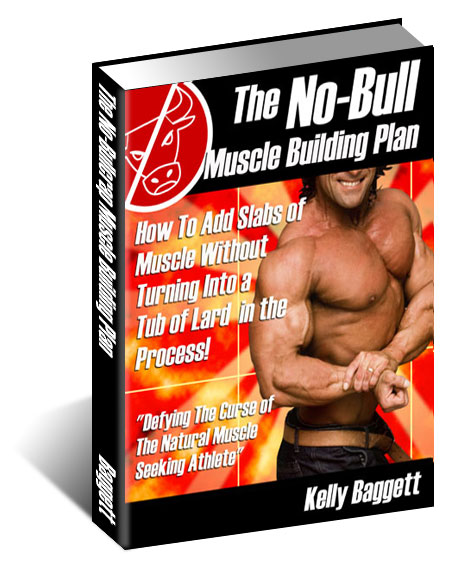
October 04, 2006
Here are my most recent updates to higher-faster-sports.com I have added a new article on sport specific exercises.
Announcement: I'm happy to announce that I will soon be releasing the first 2 training manuals/books in my new "No Bull" Series. Check out the covers:


Stay tuned over the next month or so.
New Q&A
1. Low reps, high reps, and recruitment. How to find optimal number of reps per bodypart
2. The tonic effect of strength work
3. Glute ham raises and cramps
4. Ketogenic diets
Q: What is the difference between reaching failure at 7 reps or at 20 reps? Either way, haven't you exhausted all the available muscle fibers?
Well, if you reach failure at 20 reps you're much more likely to puke from sheer exhaustion. (this is particularly true of widowmakers a.k.a. - high rep squats). Seriously, in the first case all fibers will be recruited from the first rep on. In the 2nd case all fibers won't be recruited until the end. Also, with higher reps, failure tends to occur more due to a buildup of metabolic fatigue which is why you feel so sick and "pumped" after a high rep set.
Full muscle fiber recruitment occurs from the first rep on with a load around 80-85% of maximum. Lifting a weight at this load probably gives about the best combination of recruitment and metabolic fatigue you can get with any given straight load. Thus, for growth purposes, one good way to determine the optimal number of reps you should do for a given bodypart is to simply max out on a given exercise then see how many reps you can perform with 85% of your max on that exercise. The number of reps you get with an 85% load on a given movement will tend to be the rep range that works best for you on a certain bodypart. You will probably notice with some bodyparts you can get 10 or more reps and others 5 or less. For example, with forearms I find I get about 25 reps at 85% of my max. With Hamstrings I get 4 or 5. Therefore, it should come as no surprise that my forearms respond best to sets of 25 or so and hamsrings repsond best to sets of 4-5.
Q: I just finished a program to improve my vertical a few weeks ago. it was a 12 week program and it was mostly a weight lifting until the last 4 weeks of the program when I incorporated depth jumps, sprints, bounding and some other plyos. Every single week I was improving and felt more exlosive, yet once I started to incorperate the plyos in the program my vertical dropped. After the 12 weeks I took a rest week.During that rest week I didnt workout at all. After the rest week I decided to test my vertical and it went down. I started a workout from your site last week, its only weights no plyos. yesterday i tested my vertical and it was back up to where it was in week 8 of my first program. My question is why do I jump higher and feel more explosive when im in a middle of a program? Shouldnt I get the most gains after i stop lifting/plyos for that week?
A: It sounds like you were overtraining plyo work and probably undertraining your basic strength. There is a tonic effect on the neuromusclar system from strength work that kind've "primes the pump" for explosive activities for a few days afterwards providing you don't exceed an optimal volume...do too much and you actually get an inhibtory effect. In other words, many people jump the highest and run the fastest the few days following a good leg workout due to the tonic effect loaded strength work has on the neuromuscular system.
Q: I finished off my deadlift routine and wanted to knock out some glute-ham raises (natural, no machine) to get some more focus on my hams. On the first rep my calfs felt really tense so I stopped and for about two seconds they were stuck in a contracted condition. I called it quits for the day and followed up with some stretching and massaging my calfs. They don't feel injured more like I just did a thousand calf raise. I guess this is a sort of spasm and any kind of light you could throw on the issue would be great.
A: Ahh the dreaded Glute ham cramp. It's a fairly common thing. What I would suggest next time is try to keep your feet neutral instead of flexing them. Sometimes you also have to make sure you eliminate tension at some point during each rep range or you'll get a cramp. In other words, instead of keeping your calves and hamstrings flexed throughout the entire movement, make sure you relax them at some point. Some people tend to cramp easier than others. Also pay attention to your hydration status, potassium, and magnesium intake as a deficiency in those can tend to lead to cramping. I wouldn't recommend supplementing with potassium, but an increase in potassium rich foods like vegetables and fruits can help. I do recommend supplementing with magnesium at 300 mg per day.
In your article here on getting cut, what do you think of dropping carbs below 50 or so and using a ketogenic or targeted ketogenic diet?
Yes, that would be fine. A ketogenic diet actually offers an advantage for some people in that appetite is much easier to control while in ketosis. For those that don't know, ketosis occurs when carbs are severely restricted below ~50 grams per day and the brain switches to using ketones (the end product of broken down fatty acids) as fuel, instead of glucose. When this occurs, mental energy tends to increase dramatically and appetite tends to nearly completely shut off. When you restrict carbs this severely there is an adaptation period that occurs that typically lasts 2-3 days where you'll be tired, hungry, and fatigued beyond belief, yet once you pass that few day adjustment period you'll probably love the way you feel. When you've established this state you can still take advantage of carb-ups every few days as your muscles will suck up those carbs like a sponge. However, you'll probably have to take a week or so to establish ketosis in order to make it work for you. Expect to feel like death for the first 2-3 days but after that you should feel much better.
There are different types of ketogenic diet. The first type is just a standard ketogenic diet. On this type you restrict carbs indefinitely. The old Atkins diet was an example of a straight ketogenic diet.
The 2nd type is a targeted ketogenic diet. This type of ketogenic diet is aimed at athletes and bodybuilders and still allows them to benefit from the advantages of a ketogenic diet while still replenishing glycogen. On this type of diet you severely restrict carbs at all times except just before and immediately after your workouts. You might take 50 grams of carbs before a workout and 50-100 after each workout.
The 3rd type is a cyclical ketogenic diet. On this type of diet you have periodic carb repleting or re-feed meals or days. You might go straight ketogenic diet for 4-5 days and then have 1-2 days where you replete carbs by consuming 300-1000 grams (depending on size, activity levels, etc.)
Either of these variations can work. For athletes and bodybuilders I prefer either the targeted or cyclical ketogenic diet. For a good example of fat loss schemes incorporating ketogenic type diets take a look at Lyle McDonalds Ultimate Diet 2.0 or Rob Faigin's Natural Hormonal Enhancement.
Lyle's book is geared more towards hardcore bodybuilders who want to lose fat, know how to train, love to eat, hate cardio, and aren't afraid to get really hardcore busting butt each week. It's probably not a scheme you'd want to follow indefinitely.
Faigin's book is geared more towards those who prefer a more moderate life-long type of approach.